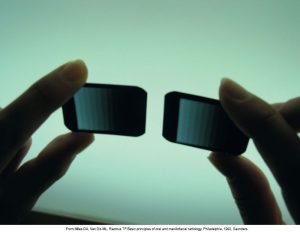17.2
Film processing is one of the most critical areas in quality control and requires daily monitoring. Film processing includes darkroom lighting, processing equipment, and processing solutions.
Darkroom Lighting
A darkroom must be checked for light tightness every month and for proper safe lighting every six months. To prepare and examine the darkroom, it must be “light-tight.” If there are no light leaks, you can proceed with film processing. And if there are light leaks, correct them with weather stripping or black tape. Most light leaks are seen around the door, through the seams of the walls or ceiling, of through a vent or keyhole.
In the Iannucci & Howerton, Dental Radiography Principles & Techniques, 6th Edition textbook on page 156, refer to the light-leak test application.
Safelighting
A coin test can be helpful in preparing a darkroom and preparing the film by placing a coin on an unwrapped, unexposed film, turning on the safelight for 3 to 4 minutes, then removing the coin and processing the film. If the image appears fogged, the safelight is not safe.
In the Iannucci & Howerton, Dental Radiography Principles & Techniques, 6th Edition textbook on page 157, refer to the safelighting test application.
Proper safelighting is when no visible image is seen on the processed dental image. Improper safelighting is if an image of the coin and a fogged background appear on the processed dental image. Below is an image showing an example of the safelighting coin test.


In the Iannucci & Howerton, Dental Radiography Principles & Techniques, 6th Edition textbook on page 156, refer to figure 17-3.
Processing Equipment
Automatic processor test films prepare films by unwrapping two unexposed films and exposing one to light, and processing both films in the automatic processor. Processing equipment must be meticulously maintained and monitored daily. Temperature, levels of water, developer, and fixer solutions must be monitored. A functioning processor is when the unexposed film appears clear and dry and the exposed film appears black and dry. A nonfunctioning processor is if the unexposed film does not appear clear and dry and if the exposed film does not appear completely black and dry, the processor is nonfunctioning. An automatic processor test should be performed with the automatic processor everyday.
In the Iannucci & Howerton, Dental Radiography Principles & Techniques, 6th Edition textbook on page 157, refer to the automatic processor test application.
Processing Solutions
Developer strength depends on reference radiographs, stepwedge radiographs, and normalizing devices. Processing solutions should be replenished daily and changed every 3 to 4 weeks.
In the Iannucci & Howerton, Dental Radiography Principles & Techniques, 6th Edition textbook on page 159, refer to table 17-1.
Reference Radiographs
Reference radiographs are processed under ideal conditions and are used to compare the film densities of radiographs that are processed daily. Reference radiographs include preparing film, exposing film using correct exposure factors, and processing film using fresh chemicals at the recommended time and temperature. To view the reference radiograph and daily radiographs side by side must be done on a viewbox. Densities can be compared on the reference radiograph with the densities on the daily radiographs.
In the Iannucci & Howerton, Dental Radiography Principles & Techniques, 6th Edition textbook on page 158, refer to the reference radiograph application.
Matched densities are if the densities seen on reference radiographs match daily radiographs and the developer solution strength is adequate. Whereas unmatched densities are daily radiographs that are lighter than reference radiographs. This means the developer solution is either weak or cold and must be replaced. Daily radiographs are darker than reference radiographs, which means the developer solution is either too concentrated or too warm and must be adjusted.
Stepwedge Radiographs
A stepwedge is a device of layered aluminum steps and is used to ensure that the developer solution is of the proper strength. To prepare the film, 20 films will be used to create a supply for daily testing. Then, you want to expose the film, process one of the exposed films with fresh chemicals, and store the remaining 19 exposed films. Process one of the exposed step wedge films each day, view the standard radiograph and the daily radiograph side by side on a viewbox, and compare the densities.
In the Iannucci & Howerton, Dental Radiography Principles & Techniques, 6th Edition textbook on page 158, refer to the stepwedge radiographs application.
If densities match, the developer solution strength is adequate. If the density on the daily radiograph differs by more than two steps from the standard, the developer solution is depleted and is considered unmatched densities. The images below show two radiographic stepwedge density scales against a light source and the grayscales of a stepwedge radiographic test pattern that are used to measure density, showing varying shades from dark to light. The middle density seen on the standard stepwedge radiographs should be used for comparison.



Normalizing Device
A normalizing device can be used to monitor developer strength and film density. It is commercially available and when the fixer solution loses strength, the film takes a longer time to clear or becomes transparent in exposed areas. When a fixer is at full strength, a film should clear within 2 minutes without agitation.
Clearing Test
While preparing film for a clearing test you are checking the film for clearing. As previously mentioned, the fixer solution removes the unexposed silver halide crystals on the film.
Fast clearing is when the film clears in 2 minutes; the fixer is of adequate strength, and slow clearing is if the film does not completely clear in 3 to 4 minutes; the fixer solution is depleted. If the fixer solution is depleted, it must be replaced before proceeding with processing.
Media Attributions
- Iannucci & Howerton: Dental Radiography Principles and Techniques, 6th Edition, Chapter 17, CC BY-NC-ND

